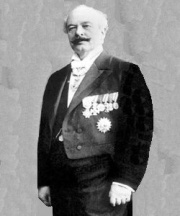Georg Luger
Contents |
[edit] Early life and military service
Georg Luger was born in Steinach am Brenner, Austria to Dr. Bartholomaeus von Luger, M.D. a surgeon. Georg grew up with Italian as his second mother tongue and finished school and Gymnasium (high school) in Padua, Italy. After graduation, his parents sent him to Vienna, where he studied at the Wiener Handelsakademie (Vienna Commercial School), the predecessor organisation of today's Vienna Business School.
In October 1867, Luger volunteered for military service as a Reserve Officer Cadet with the 78th Infantry Regiment. He was promoted to Cadett-Corporal (Officer Cadet Corporal) on June 1 1868, and to Faehnrich (Ensign) on October 1. Luger's good marksmanship brought him to the attention of his superiors, he was sent to the Austro-Hungarian Military Firearms School at Camp Bruckneudorf, where he soon became an instructor. There, his interest in automatic loading systems began. In 1871 Luger was promoted to Leutnant der Reserve (lieutenant) and moved to the military reserve.
[edit] Family
Luger married Elisabeth Josefa Dufek in 1873. He moved to Vienna with her and they had three children (in order):
- Georg Franz Luger
- Julius Wilhelm Bartholomaeus Luger (born March 16 1880)
- Friedrich Alexander Georg Luger (born April 26 1884)
Luger's first son, Georg Franz, became a civil engineer and joined his father in military weapons development. His second son fell as a Hauptmann d.R. (Reservist Captain) in World War I on the Galician front in 1915.
[edit] After the military
After leaving the military, Luger worked as an accountant and later in the management of the Jockey Club, one of the top social meeting points in Vienna.
He met with Ferdinand von Mannlicher in about 1875 and the two collaborated on rifle magazine designs, which seemed to awaken a latent talent for design within Luger.
In 1891 Luger was employed by Ludwig Loewe & Company (of Berlin, Germany). and gradually became a consultant designer.
In 1894, he was sent to demonstrate a Hugo Borchardt-designed weapon, manufactured Deutsche Waffen und Munitions Fabriken (DWM) (which had evolved from Loewe after its founder's death), to the US Army. The Army rejected the pistol, but from criticism he received, Luger improved it, creating the Parabellum pistol (commonly, and incorrectly, called a Luger). This pistol was a success for both Luger and DWM.
Luger's contract with DWM was cancelled in 1919 and he successfully sued them over patent royalties. However, Luger had lost all his savings after this time.
[edit] Bibliography
- Imperial Lugers by Jan C. Still (Still's Books - 1994)
- Third Reich Lugers by Jan C. Still (Still's Books - 1988)
- Weimar Lugers by Jan C. Still (Still's Books - 1993)
- Lugers at Random by Charles Kenyon (Hand Gun Press - 1990)
- La Luger Artiglieria by Mauro Baudino (Editoriale Olimpia - 2004)
- The Complete Handgun by Ian V Hogg (Peerage Books - 1984)
